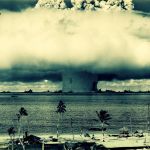Although radical Islamist terrorist organizations get the most attention from the press, a growing trend within the last six years (2009-2015) indicates that “lone wolf” terrorism is becoming the most significant domestic terrorist threat to the United States. A lone wolf terrorist is, like any other variety of terrorist, a violent political extremist. The distinctive aspect of the lone wolf terrorist is that he or she plans and perpetrates acts of terror independently, without any direct influence from a terrorist organization. Since 2001, these types of terrorist attacks are increasing in number and frequency and are particularly difficult to engage from a preventative standpoint.1 US law enforcement and intelligence agencies may need to develop fundamentally new strategies for combating and preventing lone wolf terror.
The Lone Wolf Trend
Recent evidence suggests that since 2001, non-Islamist lone wolf terrorists are the greatest domestic terrorist threat in the U.S. In February 2015, the Southern Poverty Law Center (SPLC) published a study on domestic terrorism within the US, covering sixty-two acts of terror perpetrated between the US from 01 April 2009 to 01 February 2015. According to the study, 74% of terrorist operations in the US were planned and perpetrated by single persons, and 90% of those perpetrated between April 2009 and Feb. 2015 were planned and conducted by two or fewer people. Of these later terrorist acts, half seem to have been motivated by “ideologies of hate” (i.e., Islamism, white supremacy, etc.) and the other half by antigovernment, or anarchic, ideologies. The great majority of all attacks had no connection to Islam, Islamism, or jihad.1
The real challenge of combating lone wolf terror is trying to deal with its leaderless model. Since 9/11, the US Intelligence Community and law enforcement have focused their counterterrorism efforts on stopping terrorism before it starts. This means infiltrating terrorist organizations, exposing them, and dismantling them before the terrorists have the opportunity to act. Most lone wolf terrorists, however, possess no membership to any established terrorist organization. Traditional methods of infiltrating terrorist organizations obviously cannot work when single, unaffiliated terrorists arise unpredictably out of the populace.
That is not to say that lone wolf terrorists arise out of a vacuum; indeed, ideological “hate groups” flourish throughout the US, especially in cyberspace and on social media. The online community “Hammerskin Nation” is one such group named by the Anti-Defamation League as “the most violent and best-organized neo-Nazi skinhead group in the United States.”2 Hammerskin Nation calls itself “a leaderless group of men and women who have adopted the White Power Skinhead lifestyle.” The website speaks positively of lone wolf violence and encourages racial hatred. But while communities such as Hammerskin Nation serve as the ideological fuel for lone wolf terrorism, they generally do not engage in actual conspiracy or incite anyone to commit terrorist acts and are not prosecutable.2
Case Studies in Lone Wolf Terror
Louis Beam, a prominent leader in white supremacist and neo-Nazi circles, advocated for the adoption of “leaderless resistance” in 1988.3 First proposed in 1962 by Col. Ulius Louis Amoss, the concept of leaderless resistance was originally designed as a strategy For US citizens to adopt in the event of a Communist take-over. Beam expanded on the formula and repurposed it for use by terrorist “resistance” groups within the US.
Beam knew about terrorist leadership from experience: he had led several KKK groups as well as the White Nationalist/neo-Nazi organization Aryan Nations and openly advocated the violent killing of enemies of the white race. Back in 1987, the federal government had uncovered a white supremacist terror organization and indicted fourteen of the leading white supremacists in the US. One of them was Louis Beam.3 Although Beam avoided conviction, he saw the need for a revised strategy. He argued that the traditional “pyramid” model of leadership was too easily dismantled. Another option, the “cell” model of leadership used by the Russian Communists during the Cold War, required a level of organizational sophistication that the white supremacists lacked. The only alternative, Beam argued, was “leaderless resistance.” Rather than leading organized terrorist operations, he encouraged individuals to act spontaneously in support of his cause.4
Louis Beam’s “leaderless resistance” strategy seems to be working: lone wolf terrorism is on the rise and the government currently lacks an effective means of preventing it. Lone wolf terrorists rarely (if ever) inflict the kind of damage that Al-Qaeda inflicted on 9/11, but unlike Al-Qaeda, lone wolf terrorists can come from anywhere.
- On 05 August 2012, Wade Michael Page, member of two neo-Nazi skinhead bands, entered a Sikh temple and gunned down six priests and worshipers. Law enforcement confirmed that Page, although a member of the Hammerskin community, had acted independently.5
- On 28 November 2014, Larry Steve McQuilliams, armed with an AK-47 and hundreds of rounds of ammunition, opened fire on a police station in Austin, TX. He purportedly believed God had called upon him to exterminate enemies of the white race; he had communicated his plans to no one.6
- On 10 February 2015, Craig Stephen Hicks shot and killed three Muslim students who were his neighbors. Hicks’s social media profiles revealed that he was a zealous atheist who regularly mocked Muslims and Christians and uploaded numerous images of his revolver. Hicks evidently did not share with anyone his intent to kill these victims.7
- On 17 June 2015, Dylann Roof, 21, opened fire in an African Methodist church, killing nine people. Roof later admitted he was trying to start a race war.8 A website registered in his name contained a white supremacist manifesto: “I have no choice. … Someone has to have the bravery to take it to the real world, and I guess that has to be me.”9 Although several of Roof’s friends had heard him make offhand comments that were racist and violent, none apparently believed he had any serious plans.
The Challenge of Combating Lone Wolf Terror
The incidents reported above are only a small sampling; in recent years, lone wolf attacks have become increasingly common and difficult to prevent. In an earlier era, the lone terrorist was generally a member of an actual organization. Organizations such as the KKK had to meet together in physical locations. Now, with the advent of the internet, the challenge of predicting lone wolf behavior has increased exponentially. Members of online communities such as Hammerskin Nation are loosely affiliated and generally anonymous. Tracing a forum post back to an actual person is significantly more involved than listening in on a KKK meeting. Individuals often self-radicalize through heavy exposure to such communities but do not necessarily take much active personal involvement in online discussions.1
Even when extremists can be identified, it is difficult to convict them prior to their attacks. In the words of former FBI agent and author of Hunting Terrorists Joe Navarro, “isolating yourself and ideating [sic] hatred in and of itself is not an offense.”1 Membership in an extremist community is not grounds for arrest, nor even is leadership. Even the charge of conspiracy cannot be brought against potential terrorists because lone wolves do not share their plans with their larger communities; no one is privy to the plan of attack except the terrorist himself. US law enforcement faces the conundrum of dealing with radicalizing communities that produce terrorists indirectly without inciting violence openly in a legally prosecutable way.1
The most straightforward approach to dealing with these types of terrorist threats is to infiltrate their extremist communities and then listen in for signs of danger. This technique has had mixed results. The above mentioned sedition trials in 1988, for example, successfully uncovered the conspiracy, but ultimately all of the fourteen men were acquitted due to lack of evidence. The possibility of convicting conspirators today in a lone wolf scenario is far more slight. Infiltrating a group’s leadership is not a tactic that suited for reaching the main objective of finding and shutting down potential terrorists.1
In terms of prevention, the best option for defeating lone wolf terror may be to target the propagandists rather than the terrorists. Without the ideological backing of online communities, many would-be terrorists would never radicalize. While many of the leaders in these hate communities might not themselves be terrorists, there is a good chance that they are engaged in one type of illegal behavior or another.
Ultimately, the US does not have a very good answer to lone wolf terrorism today. The problem of consistently preventing lone wolf terrorism before it takes place is real and unsolved. Preventative strategies have had negligible success as evidenced by the continuing increase in these types of violence. The US Intelligence Community and law enforcement may need to experiment with new ideas and formulas in order to overcome the primary challenges raised by lone wolf terrorism. ■
- “Lone Wolf Report,” Southern Poverty Law Center, 11 February 2015, https://www.splcenter.org/20150212/lone-wolf-report.
- “The Hammerskin Nation,” Anti-Defamation League, 29 July 2002, http://archive.adl.org/learn/ext_us/hammerskin.html.
- “Louis Beam,” Anti-Defamation League, 2005, http://archive.adl.org/learn/ext_us/beam.html.
- Louis Beam, “Leaderless Resistance,” The Seditionist, February 1992, http://www.louisbeam.com/leaderless.htm.
- Kim Murphy, “Sikh temple shooter seems to have followed ‘lone wolf’ path,” Los Angeles Times, 09 August 2012, http://articles.latimes.com/2012/aug/09/nation/la-na-sikh-temple-shooting-20120809.
- “Exclusive: Police bullet to heart kills downtown shooter,” Kvue, 19 January 2015, http://www.kvue.com/story/news/local/2014/11/28/chief-acevedo-hints-at-type-of-weapon-downtown-shooter-used/19641717/.
- Steven Rosenfeld, “Angry, armed and white: Why Craig Stephen Hicks is the face of America’s violent extremism,” Salon, 14 February 2015, http://www.salon.com/2015/02/14/angry_armed_and_white_why_craig_stephen_hicks_is_the_face_of_
americas_violent_extremism_partner/. - Meg Kinnard and Bruce Smith, “Dylann Roof pleads not guilty – but wants to plead guilty – in Charleston case,” USA Today, 19 August 2015, http://www.usatoday.com/story/news/nation/2015/07/31/dylann-roof-charleston-plea/30939001/.
- Dylann Roof, lastrhodesian.com, 20 June 2015, https://web.archive.org/web/20150620135047/http://lastrhodesian.com/data/documents/rtf88.txt.





